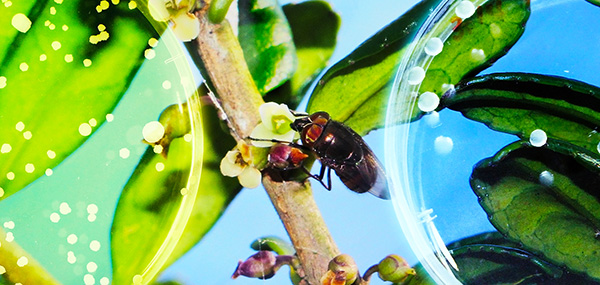Researchers find that plants house different amounts and types of microorganisms depending on sex
The regal mane of a lion or psychedelic tail of a peacock are two ways in which sexual characteristics stand out in the animal kingdom. Although less vivid, some plants also have gender differences, ones that can have big effects on the ecological community.
A new study published in Ecology by Kaoru Tsuji from the Center for Ecological Research at Kyoto University and Tadashi Fukami from Stanford University shows that plant gender can have a great influence on the amount and types of bacteria and fungi residing in flowers.
Sexual differences, such as the size of an individual, influence how an animal or plant interacts with its environment. They even influence how plants interact with the entire community of bacteria and fungi.
"Male and female flowers have different chemical composition of nectar. We found that these differences affect how communities of microorganisms develop in flowers," says Tsuji.
Nectar is home to many different species of bacteria and fungi. To investigate how female and male plants affect bacterial and fungal communities in nectar, Tsuji and Fukami looked at two plants common in Japan, Eurya emarginata and Eurya japonica .
In these plants, female flowers have richer nectar. The two scientists thought that the different levels of sugars and other chemicals in the nectar might affect the type of microbes residing in it.
That expectation was what they actually found, as male flowers had more bacteria and fungi than female flowers, but also of different types.
"We found, for example, that the most common bacterium in female flowers, Acinetobacter boissieri , was not common in male flowers. These findings show sexual differences can affect not just total abundance, but also species composition in microbial communities," notes Fukami.
In addition, they found that the order of arrival of different species of microorganisms influenced the community, but only in female plants.
"When we inoculated a certain fungus to the plants, they became more abundant when it was introduced after the inoculation of a different fungal species. This suggests a facilitative effect, although we still do not know the mechanism," says Tsuji.
Historically, the evolution of gender and sex has been studied primarily to understand passing genes to progeny. This study shows, however, that sex has an effect on much more than just offspring.
"We found that male and female plants have a significant impact on the populations of other species, showing that sex has a wider impact on the environment," concludes Tsuji.

Researchers find microorganism biodiversity in plants depending on sex (Kyoto University)
Paper information
【DOI】 https://doi.org/10.1002/ecy.2494
【KURENAI ACCESS URL】 http://hdl.handle.net/2433/234585
Kaoru Tsuji, Tadashi Fukami (2018). Community-wide consequences of sexual dimorphism: evidence from nectar microbes in dioecious plants. Ecology, 99(11), 2476-1484.





